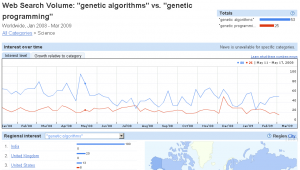Hello ! This is the 2nd post related to the Pyevolve on portable devices, the first was in the Sony PSP here and the PoC of Pyevolve solving the TSP problem with a graphical output of best individuals on the Sony PSP screen. Now, it’s time to go further and run Pyevolve into the most portable device used by us, the cellphone.
Using the new version of the PyS60, the release 1.9.1, which comes with the new amazing 2.5.1 Python core, I’ve executed the Pyevolve with no problem, and I was very surprised by the performance of the GA on the Nokia N73, the GA I’ve ran is the minimization of one of the De Jogn’s test suite functions, the Sphere function, the function is very simple and I’ve used 5 real variables between the interval of [-5.12, 5.12], the Gaussian Real Mutator and the Single Point Crossover of the Pyevolve framework. Also I’ve set a population size of 80 individuals and the mutation rate of 2% and crossover rate of 90%.
After 18 generations (about 8 seconds), the GA ended with the best score of 0.0, representing the optimal minimization of the De Jong’s Sphere function.
Follow some screenshots of the adventure (click on the pictures to enlarge):
How to install Pyevolve on the PyS60 ?
1) First, you need to install the PyS60 for your Symbian platform. Here is the installation manual. The order of the installation is: Python Runtime for S60, Python Script Shell and PIPS Library.
2) Then, you must create a directory on your Memory Card, inside the “Python” directory, named “Lib”, and inside this directory, you copy the “pyevolve” folder. The absolute folder structure will be like this:
MemoryCard:\Python\Lib\pyevolve
Some features of the framework will not work, like the some DB Adapters, however, the GA core is working really good. I’ve used the Pyevolve subversion release r157, but it should works with the 0.5 release too. I’ve not finished the documentation of the new release, I’m working on some features yet.
Here is the source code I’ve used to minimize the De Jong’s Sphere function:
import e32
print "Loading Pyevolve modules...",
e32.ao_yield()
from pyevolve import G1DList, GSimpleGA
from pyevolve import Initializators, Mutators, Consts
print " done !"
e32.ao_yield()
def sphere(xlist):
n = len(xlist)
total = 0
for i in range(n):
total += (xlist[i]**2)
return total
def ga_callback(ga_engine):
gen = ga_engine.getCurrentGeneration()
best = ga.bestIndividual()
print "Generation %d - Best Score: %.2f" % (gen, best.score)
e32.ao_yield()
return False
if __name__ == "__main__":
genome = G1DList.G1DList(5)
genome.setParams(rangemin=-5.12, rangemax=5.13, bestRawScore=0.00, roundDecimal=2)
genome.initializator.set(Initializators.G1DListInitializatorReal)
genome.mutator.set(Mutators.G1DListMutatorRealGaussian)
genome.evaluator.set(sphere)
ga = GSimpleGA.GSimpleGA(genome)
ga.setMinimax(Consts.minimaxType["minimize"])
ga.setGenerations(100)
ga.setMutationRate(0.02)
ga.terminationCriteria.set(GSimpleGA.RawScoreCriteria)
ga.stepCallback.set(ga_callback)
ga.evolve()
best = ga.bestIndividual()
print "\nBest individual score: %.2f" % (best.score,)
You can note the use of the module “e32” of the PyS60, this is used to process pending events, so we can follow the statistics of current generation while it evolves.
I hope you enjoyed this work, the next step is to port the TSP problem to cellphone =)
Some time ago I’ve asked Guido van Rossum on the Google Moderator about the future of Python for mobile phones (aka PyS60), and here is the full answer from him:
I’m hopeful, but concerned that Java has cornered this market. For example, the Android development kit is extremely slick but only supports Java at the moment. There’s no doubt about which is the dominant app development language on most mobile platforms, including S60 and anything Symbian-based. In the long run I expect Python to just happen on mobile devices, as increases in disk space will allow the set of pre-installed tools to grow. In the mean time I see a bigger role for Python server-side, for example there are iPhone apps backed by services written in Python running on App Engine (and probably also apps backed by Python running on other server platforms).
Guido van Rossum, San Francisco Bay Area
Well, I think that with this new version of PyS60, with the 2.5.1 core, the Python on mobiles can be very useful and productive. Recently, Nokia have signed a loan agreement with the European Investment Bank (EIB) to the tune of €500 million ($623.9 million). According to Reuters, the five-year loan will be used in part to “finance software research and development (R&D) projects Nokia is undertaking during 2009-2011 to make Symbian-based smartphones more competitive.” So I’m with great expectations with this new investment on Symbian smartphones and with the future possibilities of the PyS60.

